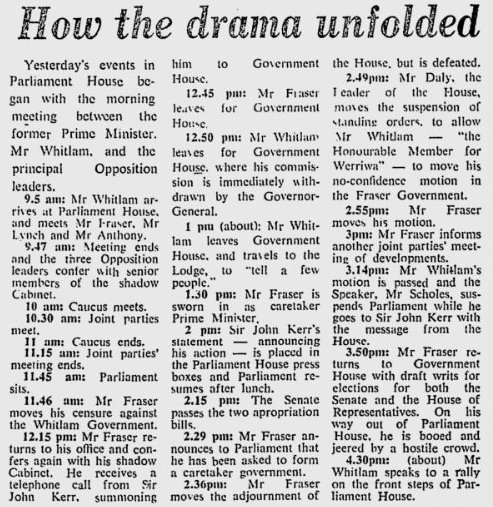October 1975
- October 14: Minerals and Energy Minister, Rex Connor, resigns after being shown to have misled Parliament over ongoing negotiations for overseas loans with Tirath Khemlani. He is replaced by Paul Keating.
- October 15: Every metropolitan newspaper in Australia calls on the Government to resign. Fraser announces that the Senate will delay the two money bills until Whitlam calls an election.
- October 16: The Senate blocks the money bills, whilst the House of Representatives passes a motion of confidence in the government.
- October 16-November 8: The Parliament debates the constitutional crisis, with the House consistently reaffirming its confidence in the government. Both sides of politics conduct rallies around the country. Public opinion polls show a swing to the government. The Governor-General, Sir John Kerr, speaks with both Whitlam and Fraser on a number of occasions.
November 1975
By early November, the crisis was no nearer resolution. Rallies and campaigns for and against the actions of the Opposition were being held across Australia.
- November 03: Fraser offered to pass the Supply Bills, provided Whitlam agreed to call an election by May 1976. Whitlam rejected the offer.
- November 10: The Chief Justice of the High Court, Sir Garfield Barwick, a former Liberal Government minister, sees the Governor-General. Later, he gives Kerr a letter that the Governor-General releases the next day to support his decision.
November 11, 1975
The events of this momentous day in Australia’s political history occurred on the day the nation remembers its war dead and on the anniversary of the hanging of Ned Kelly.
- 9.00am: Whitlam meets with Fraser and other Opposition leaders. He says that he will call a half-Senate election immediately unless the money bills are passed.
- 10.00am: Whitlam makes an appointment to see Kerr.
- 10.10am: The Labor caucus is told by Whitlam that there will be a Senate election.
- 10.30am: Fraser tells the Opposition parties there is nothing to report.
- 11.45am: House of Representatives meets and debates yet another motion of confidence in the government.
- 12.10pm: Kerr’s private secretary phones Fraser to tell him to go to Government House at 1.00pm.
- 12.45pm: Fraser leaves for Government House, where he is shown into a waiting room.
- 12.50pm: Whitlam leaves for Government House, not knowing Fraser is there.
- 1.15pm: Kerr dismisses Whitlam.
- 1.30pm: Kerr commissions Fraser as Prime Minister.
- 2.00pm: The Senate passes the Supply bills.
- 2.30pm: Fraser announces to the House of Representatives that he is Prime Minister, moves that the House of Representatives adjourn, but is defeated.
- ABC Radio Coverage: Around this time the ABC went to live, continuous broadcasting of the political events in Canberra, providing a remarkable audio record of the day.
- 3.03pm: Whitlam moves a motion of no-confidence in Fraser.
- 3.16pm: House of Representatives passes motion of no-confidence in Fraser. The Speaker asks for an appointment with Kerr, but is told that Kerr cannot see him until 4.45pm.
- 4.50pm: The Governor-General’s secretary, David Smith, goes to Parliament House and reads the proclamation dissolving Parliament. The proclamation concludes with the words “God Save the Queen.” Whitlam declares that “nothing will save the Governor-General” and implores his supporters to maintain their “rage and enthusiasm”.
This is how the Sydney Morning Herald reported the chronology of the day’s events on November 12, 1975:

December 1975
- Dec 13: The ALP is defeated at the polls. The Fraser Government secures the largest majority in Australian Federal political history.
